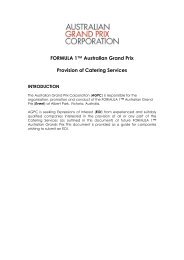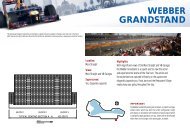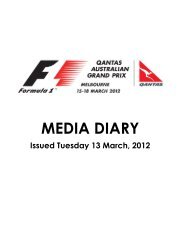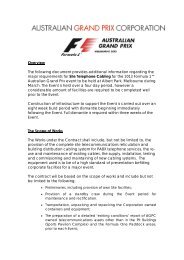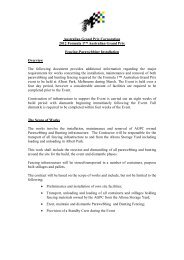2013 AnnuAl RepoRt - Australian Grand Prix
2013 AnnuAl RepoRt - Australian Grand Prix
2013 AnnuAl RepoRt - Australian Grand Prix
You also want an ePaper? Increase the reach of your titles
YUMPU automatically turns print PDFs into web optimized ePapers that Google loves.
Notes to and Forming Part of the Financial Statementsfor the Financial Year Ended 30 June <strong>2013</strong>Held-to-maturity financial assetsIf the Corporation has the positive intent and ability to hold nominated investments tomaturity, then such assets may be classified as held-to-maturity. Held-to–maturity financialassets are recognised initially at fair value plus any directly attributable transaction costs.Subsequent to initial recognition, held-to-maturity financial assets are measured at amortisedcost using the effective interest method, less any impairment losses.The held-to-maturity category includes certain term deposits and debt securities for which theCorporation intends to hold to maturity.The Corporation makes limited use of this classification because any sale or reclassification ofmore than an insignificant amount of held-to maturity investments not close to their maturitywould result in the whole category being reclassified as available-for–sale. The Corporationwould also be prevented from classifying investment securities as held-to-maturity for thecurrent and the following two financial years.Financial assets and liabilities at fair value through profit and lossFinancial assets are categorised as fair value through profit and loss at trade date if they areclassified as held for trading or designated as such upon initial recognition. Financialinstrument assets are designated at fair value through profit or loss on the basis that thefinancial assets form part of a group of financial assets that are managed by the Corporationbased on their fair values, and have their performance evaluated in accordance withdocumented risk management and investment strategies.Financial instruments at fair value through profit or loss are initially measured at fair value andattributable transaction costs are expensed as incurred. Subsequently, any changes in fairvalue are recognised in the net result as other economic flows. Any dividend or interest on afinancial asset is recognised in the net result from transactions.Financial liabilities at amortised costFinancial instrument liabilities are initially recognised on the date they are originated. They areinitially measured at fair value plus any directly attributable transaction costs. Subsequent toinitial recognition, these financial instruments are measured at amortised cost with anydifference between the initial recognised amount and the redemption value beingrecognised in the profit and loss over the period of the interest bearing liability, using theeffective interest rate method.Financial instrument liabilities measured at amortised cost include all payables, deposits heldand advances received, and interest-bearing arrangements other than those designated atfair value through profit or loss.Offsetting financial instrumentsFinancial instrument assets and liabilities are offset and the net amount presented in thebalance sheet when, and only when, the Corporation has the legal right to offset theamounts and intend either to settle on a net basis or to realise the asset and settle the liabilitysimultaneously.Reclassification of financial instrumentsSubsequent to initial recognition and under rare circumstances, non-derivative financialinstruments assets that have not been designated at fair value through profit3838<strong>Australian</strong> <strong>Grand</strong> <strong>Prix</strong> Corporation Annual Report <strong>2013</strong>



